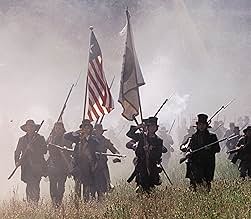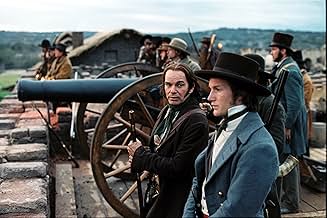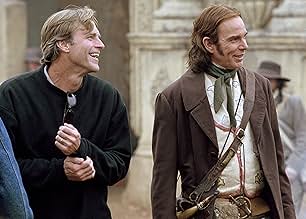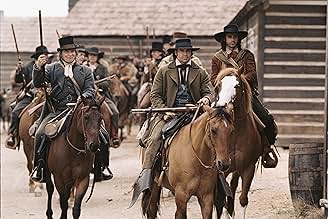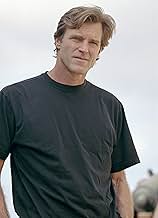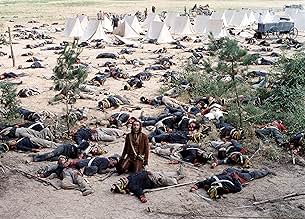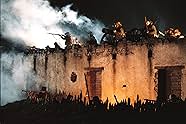Basierend auf dem Patt zwischen einer Gruppe von Texanern und Tejano-Männern, angeführt von Davy Crockett und Jim Bowie, und den Truppen des mexikanischen Diktators Santa Anna im Jahr 1836.Basierend auf dem Patt zwischen einer Gruppe von Texanern und Tejano-Männern, angeführt von Davy Crockett und Jim Bowie, und den Truppen des mexikanischen Diktators Santa Anna im Jahr 1836.Basierend auf dem Patt zwischen einer Gruppe von Texanern und Tejano-Männern, angeführt von Davy Crockett und Jim Bowie, und den Truppen des mexikanischen Diktators Santa Anna im Jahr 1836.
- Regie
- Drehbuch
- Hauptbesetzung
- Auszeichnungen
- 1 Nominierung insgesamt
- Private Gregorio Esparza
- (as Ricardo S. Chavira)
Empfohlene Bewertungen
While each of the story's principals (David Crockett, James Bowie, William Barret Travis, Sam Houston, and Antonio Lopez de Santa Ana) are de-mythologized, it is Crockett (brilliantly conceived by Billy Bob Thornton) who captures and holds your attention. Neither the folksy backwoodsman (as portrayed previously by Fess Parker and Arthur Hunnicutt), nor the hero answering an oppressed people's call for help (John Wayne's 'take' on Crockett), Thornton's Crockett is a well-dressed country 'sophisticate', who plays the violin and the political game in Washington very well. As the film opens, he attends a Washington production of "The Lion of the West", based on his fictional exploits, with a leading man dressed in what we today consider the 'Official Crockett Uniform' of buckskins and a coonskin cap. The character on stage, and the legends surrounding him which would ultimately incorporate the Alamo as it's final act, is the 'DAVY Crockett' we all know, but the 'real' David Crockett, according to Hancock, is an opportunist who sees political rebirth in Texas, and arrives hoping the battle is already over. Thornton is masterful, showing Crockett's ambition, his fear of having to 'live up' to the legends surrounding him, and his gradual emergence into a true hero, who would defy Santa Ana with his last breath.
The other leads aren't given as much screen time for character development, with the exception of Dennis Quaid's Sam Houston, a heavy-drinking pragmatist with a political agenda and ambitions of his own. Patrick Wilson's Travis is a failure as a father and husband, hoping to rebuild his life and reputation in Texas; Jason Patric's Bowie is a glowering, unsavory adventurer/businessman, involved in slave trafficking, and terminally ill during the siege (Hooker does, however, bow to legend, allowing the dying Bowie a chance to fire his pistols at the Mexicans before being overwhelmed). Emilio Echevarría, the first Mexican to ever play Santa Ana in an American film, has gotten bad press for his portrayal of the leader as a loud-mouthed, insensitive, lecherous egotist, but from all accounts, that WAS what the real Santa Ana was like.
While the slow pacing of most of the film is a problem, the film's final half hour appears rushed, as the Alamo's fall jumps quickly into Sam Houston's victory over Santa Ana, at San Jacinto (an event that occurred after a momentous six weeks of defeat and tragedy barely touched upon by Hancock). While it is understandable that the film makers wanted an 'upbeat' ending, it comes across as jarring, nonetheless.
If you like your heroes and history 'bigger than life', the 2004 ALAMO will disappoint, and you should stick to John Wayne's version. If, however, you want a new perspective, and are willing to dispense with the preconceptions of the past, this film has a LOT to offer!
This film takes the middle road which, like all compromises, is guaranteed to leave both sides unsatisfied. I believe this simple fact underlies many of the poor reviews this film received.
It is to the film's credit that it presents the most historically credible version of the events leading up to the birth of the Republic of Texas. To be sure, there are still points which may be quibbled over. But without the benefit of a time machine, it's difficult to come up with a more reliable exposition of the known facts.
And that is, to many critics, another of the film's weaknesses. The average movie goer wants to be entertained and reacts negatively to any obvious attempt to educate him/her in the process. That's a sad commentary on our society, but that's the way it is. This movie could have been more entertaining, but then it wouldn't have been as educational. I appreciate accuracy and educational value in historical films, so I really liked it.
The bottom line is this... If you're looking for a familiar retelling of the Alamo story which sticks to the established mythology, this isn't for you. If you're looking for a complete retelling which turns the entire story on its ear, this isn't for you. If you're looking for mindless entertainment, this isn't for you. If you're looking for a real story of real people who changed the face of America, this is a really good film.
I am very easily bored. At just over 2 hours, I found this film captivating. Poorly done? John Lee Hancock's film is one of the most effectively produced I can remember. Not one moment of this film was shot on a sound stage. They took 50 acres in Texas and actually rebuilt the entire city of San Antonio de Behar and the Alamo and shot the entire movie in situ.
But the most amazing aspect of these reviews is the repeated accusation of lack of character development. I came away from this film understanding for the first time who William Barrett Travis, David Crockett, James Bowie and Sam Houston really were. The human underneath the legend as it were. David Crockett (Billy Bob Thornton) has a great line in this movie: "If it were just me, simple David from Tennessee, I might go over that wall one night and take my chances. But this Davy Crockett feller - people are watching him". Lack of character development? I don't think so.
The piece de resistance, though, and the one that made me take fingers to keys and write this review (something I almost never do) was the review which claims there was no tribute given to Tejano assistance in the Texas Revolution. Did this person see the same film I did? Or did he/she take a bathroom break every time Juan Seguin's character was on screen? The PRIMARY thing I learned from this historically accurate-as-possible-when-making-a-movie film was ... ta da .... the involvement of the Tejanos! I had never really considered before that there was a brother-against-brother aspect to the Alamo, but it was very implicit in this film.
Ignore the negative reviews, particularly if you are a history buff, and see this film.
The film is correctly based on historic events . The stalwart but tragic defense has become one of American history's most often repeated legends,although historical research has revealed a few facts that go unmentioned.For instance,Sam Houston,commander in chief of the Texas forces,never felt that the crumbling mission could stand up to a siege,and ordered frontiersman Jim Bowie to destroy.He didn't ,however,and rescinded the order and sent attorney turned colonel William B.Travis to defend it.The force that remained in the mission the date the siege began,is estimated at between 182 .Of these less than 20 were actually Texans,the rest including Bowie and another frontier legend,Davy Crookett were volunteers.Early all of them believed that reinforcements were only a short time away.Santa Anna Launched a pre-dawn attack.To the strains of ¨deguello¨a battle march indicating that no quarter would be given,or no prisoners taken,some 1800 Mexicans troops stormed the fort.They were thrown back by the cannon and rifles of the defenders,they rushed again,and were repulsed a second time.Eventually Santa Anna sent another wave of troops who broke the outer defenses and forced the Texans to retreat,fighting hand to hand.When the fighting was over,there were no survivors among the defenders.The myth that the garrison fought to the last man ,however isn't quite accurate,since the evidence indicates that Davy Crockett and several others were captured and possibly tortured,then executed.That they died bravely has never been disputed.William Travis who at least according to legend,invited all who would stay and die with him to cross the line in the dirt,fell near a cannon at the north wall.And Jim Bowie,already deathly ill from a sickness that had recently claimed wife and children,fought from his sickbed near the main gate.Like many others among the defenders Bowie was armed with the formidable hunting knife named for him.The legendary defense served as a rallying point for the beleaguered Texas.Although Santa Anna ,who lost at least 600 of some 3000 troops against a force of less than 200,referred as a small affair,the valor of the defenders gave the surviving Texan troops something to remember and thus they did,six weeks later at San Jacinto,but a new battle cry had been added to the annals of American history:¨Remember the Alamo¨
Wusstest du schon
- WissenswertesSeveral people that played Texan extras in the movie are actual descendants of the defenders of the Alamo.
- PatzerContrary to the popular image, this movie accurately portrays the Alamo without its iconic bell-shaped facade atop the front wall of the church. That was added by the U.S. Army in 1850, 14 years after the battle. The John Wayne 1960 version made a half-hearted attempt to recreate the facade as it exists now, but in fact, the roof of the church was flat all the way across in 1836.
- Zitate
Issac Millsaps: So, Davy, all your Indian fightin'... you ever get into a scrape like this?
Davy Crockett: I was never in but one real scrape in my life, fella.
Issac Millsaps: Yeah, but you was in the Red Stick war.
Davy Crockett: Yeah, it's true, I was in that. I sure was. I was just about your age when it broke out. The Creeks, uh, boxed up about 400 or 500 people at Fort Mims and, uh, massacred every one of 'em. 'Course this was big news around those parts, so I up and joined the volunteers. I did a little scoutin', but mostly I, I just fetched in venison for the cook fire, things of that nature. Well, we caught up with those redskins at Tallushatchee, surrounded the village, come in from all directions. Wasn't much of a fight, really. We just shot 'em down like dogs. Finally... what Injuns was left, they crowded into this little cabin. They wanted to surrender... but this squaw, she loosed an arrow and killed one of the fellas, and then we shot her, And then we set the cabin on fire. We could hear 'em screamin' for their gods in there. We smelled 'em burnin'. We'd had nary to eat but parched corn since October. And the next day, when we dug through the ashes, we found some potaters from the cellar. They'd been cooked by that grease that run off them Indians. And we ate till we nearly burst. Since then... you pass the taters and I pass 'em right back.
- VerbindungenFeatured in Return of the Legend: The Making of 'The Alamo' (2004)
- SoundtracksOpus 76-5 -- String Quartet No. 79 in D Major Final Presto
Written by Joseph Haydn
Top-Auswahl
- How long is The Alamo?Powered by Alexa
Details
- Erscheinungsdatum
- Herkunftsland
- Sprachen
- Auch bekannt als
- El Álamo
- Drehorte
- Reimer's Ranch - 23610 Hamilton Pool Road, Dripping Springs, Texas, USA(Alamo and Bexar scenes)
- Produktionsfirmen
- Weitere beteiligte Unternehmen bei IMDbPro anzeigen
Box Office
- Budget
- 107.000.000 $ (geschätzt)
- Bruttoertrag in den USA und Kanada
- 22.414.961 $
- Eröffnungswochenende in den USA und in Kanada
- 9.124.701 $
- 11. Apr. 2004
- Weltweiter Bruttoertrag
- 25.819.961 $
- Laufzeit2 Stunden 17 Minuten
- Farbe
- Sound-Mix
- Seitenverhältnis
- 2.35 : 1
Zu dieser Seite beitragen






